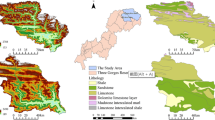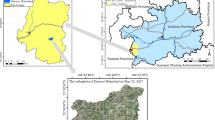Abstract
The Revised Universal Soil Loss Equation (RUSLE) was applied to assess the spatial distribution and dynamic properties of soil loss with geographic information system (GIS) and remote sensing (RS) technologies. To improve the accuracy of soil-erosion estimates, a new C-factor estimation model was developed based on land cover and time series normalized difference vegetation index (NDVI) datasets. The new C-factor was then applied in the RUSLE to integrate rainfall, soil, vegetation, and topography data of different periods, and thus monitor the distribution of soil erosion patterns and their dynamics during a 30-year period of the upstream watershed of Miyun Reservoir (UWMR), China. The results showed that the new C-factor estimation method, which considers land cover status and dynamics, and explicitly incorporates within-land cover variability, was more rational, quantitative, and reliable. An average annual soil loss in UWMR of 25.68, 21.04, and 16.80 t ha−1 a−1 was estimated for 1990, 2000 and 2010, respectively, corroborated by comparing spatial and temporal variation in sediment yield. Between 2000 and 2010, a 1.38% average annual increase was observed in the area of lands that lost less than 5 t ha−1 a−1, while during 1990–2000 such lands only increased on average by 0.46%. Areas that classified as severe, very severe and extremely severe accounted for 5.68% of the total UWMR in 2010, and primarily occurred in dry areas or grasslands of sloping fields. The reason for the change in rate of soil loss is explained by an increased appreciation of soil conservation by developers and planners. Moreover, we recommend that UWMR watershed adopt further conservation measures such as terraced plowing of dry land, afforestation, or grassland enclosures as part of a concerted effort to reduce on-going soil erosion.
Similar content being viewed by others
Reference
Brath A, Castellarin A, Montanari A (2002) Assessing the effects of land-use changes on annual average gross erosion. Hydrology and Earth System Sciences Discussions 6(2): 255–265. DOI:10.5194/hess-6-255-2002.
Cerdà A (1999) Parent material and vegetation affect soil erosion in eastern Spain. Soil Science Society of America Journal 63: 362–368. DOI:10.2136/sssaj1999.03615995006300020014x.
Chen T, Niu R, Li P, et al. (2011) Regional soil erosion risk mapping using RUSLE, GIS, and remote sensing: a case study in Miyun Watershed, North China. Environmental Earth Sciences 63(3): 533–541. DOI: 10.1007/s12665-010-0715-z.
deAsis AM, Omasa K (2007) Estimation of vegetation parameter for modeling soil erosion using linear Spectral Mixture Analysis of Landsat ETM data. ISPRS Journal of Photo grammetry and Remote Sensing 62(4): 309–324. DOI:10.1016/j.isprsjprs.2007.05.013.
De Jong SM (1994) Applications of reflective remote sensing for land degradation studies in a Mediterranean Environment. PhD thesis, Utrecht University, the Netherlands. p 237.
De Jong SM, Riezebos HT (1997) SEMMED: a distributed approach to soil erosion modeling. In: Spiteri A (ed.), Remote Sensing’ 96: Integrated Applications for Risk Assessment and Disaster Preventionfor the Mediterranean. Balkema, Rotterdam. pp 199–204.
De Jong SM, Paracchini ML, Bertolo F, et al. (1999) Regional assessment of soil erosion using the distributed model SEMMED and remotely sensed data. Catena 37(3–4): 291–308. Doi: 10.101 6/S0341-8162(99)00038-7.
Foster GR, Flanagan DC, Nearing MA, et al. (1995) WEPP: USDAWater Erosion Prediction Project Technical Documentation. pp 1–12. (http://www.ars.usda.gov/SP2UserFiles/ad_hoc/36021500WEPP/chap11.pdf, accessed on 2011-06-10)
García-Orenes F, Cerdà A, Mataix-Solera J, et al. (2009) Effects of agricultural management on surface soil properties and soil-water losses in eastern Spain. Soil and Tillage Research 106: 117–123. DOI:10.1016/j.still.2009.06.002.
García-Orenes F, Guerrero C, Roldán A, et al. (2010) Soil microbial biomass and activity under different agricultural management systems in a semiarid Mediterranean agro-ecosystem. Soil and Tillage Research 109(2): 110–115. DOI:10.1016/j.still.2010.05.005.
Huete A, Didan K, Miura T, et al. (2002) Overview of the radiometric and biophysical performance of the MODIS vegetation indices. Remote Sensing of Environment 83(1-2): 195–213. DOI: 10.1016/S0034-4257(02)00096-2.
Jain MK, Kothyari UC and RangaRaju KG (2004) A GIS based distributed rainfall-runoff model. Journal of Hydrology 299(1): 107–135. DOI:10.1016/j.jhydrol.2004.04.024.
Jürgens C, Fander M (1993) Soil erosion assessment by means of Landsat-TM and ancillary digital data in relation to water quality. Soil technology 6(3): 215–223. DOI: 10.1016/0933-3630(93)90011-3.
Kirkby M, Jones RJA, Irvine B, et al. (2004) Pan-European Soil Erosion Risk Assessment for Europe: the PESERA map, version 1 October 2003. (http://eusoils.jrc.ec.europa.eu/esdb_archive/eusoils_docs/esb_rr/n16_ThePeseraMapBkLet52.pdf, accessed on 2010-08-25)
Lin CY, Lin WT, Chou WC (2002) Soil erosion prediction and sediment yield estimation: the Taiwan experience. Soil and Tillage Research 68(2): 143–152. DOI:10.1016 /S0167-1987(02)00114-9.
Liu BY, Nearing MA, Risse LM (1994) Slope gradient effects on soil loss for steep slopes. Transactions of the American Society of Agricultural Engineers 37(6): 1835–1840.
Ma JW, Xue Y, Ma CF, et al. (2003)A data fusion approach for soil erosion monitoring in the Upper Yangtze River Basin of China based on Universal Soil Loss Equation (USLE) model. International Journal of Remote Sensing 24(23): 4777–4789. DOI: 10.1080/0143116021000056028.
Ma ZZ (2002) Water and soil conservation ecological construction measures layout in view of the present situation of water and soil loss in the Hai Basin. Haihe water resources5(4): 5–9. (In Chinese)
Morgan RPC (1995) Soil Erosion and Conservation. Longman Group Limited, Essex, UK. pp 116–149.
Mccool DK, Foster GR, Mutchler CK, et al. (1989) Revised slope length factor for the Universal Soil Loss Equation. Transactions of the American Society of Agricultural Engineers 32(5): 1571–1576.
Morgan R, Quinton J, Smith R, et al. (1998) The European Soil Erosion Model (EUROSEM): a dynamic approach for predicting sediment transport from fields and small catchments. Earth Surface Processes and Landforms 23(6): 527–544.
Renard KG, Foster GA, Weesies GA, et al. (1997) Predicting soil erosion by water: a guide to conservation planning with RUSLE. USDA Agriculture Handbook No. 703, Washington DC, USA.
Research Group on Soil Taxonomy, Institute of Soil Science, Chinese Academy of Sciences, Cooperative Research Group on Chinese Soil Taxonomy (1995) Chinese Soil Taxonomy (Amendment).China Agricultural Science and Technology Publishing House, Beijing, China.
Shirazi MA, Boersma L (1984) A unifying quantitative analysis of soil texture. Soil Science Society of America Journal 48(1): 142–147.
Song XF, Zheng D, Niu HS, et al. (2009) Estimation of the cover and management factor for modeling soil erosion using remote sensing. Journal of Beijing Forestry University 31(3): 58–63. (In Chinese). DOI:10.3321/j.issn:1000-1522.2009.03.011.
Van der Knijff JM, Jones RJA, Montanarella L (2000) Soil erosion risk assessment in Europe. pp 1–38. (http://eusoils.jrc.ec.europa.eu/ESDB_Archive/pesera/pesera_cd/pdf/ereurnew2.pdf, accessed on 2012-08-10)
Tarnavsky E, Garrigues S, Brown ME (2008) Multiscale geostatistical analysis of AVHRR, SPOT-VGT, and MODIS global NDVI products. Remote Sensing of Environment 112(2): 535–549. DOI:10.1016/j.rse.2007.05.008.
The Ministry of Water Resources of the People’s Republic of China (1997) SL 190-1996 national professional standards for classification and gradation of soil erosion. China Water & Power Press, Beijing, China. pp 3–14. (In Chinese)
Vrieling A (2006) Satellite remote sensing for water erosion assessment: A review. Catena 65(1): 2–18. DOI: 10.1016/j.catena.2005.10.005.
Vrieling A, de Jong SM, Sterk G, et al. (2008) Timing of erosion and satellite data: A multi-resolution approach to soil erosion risk mapping. International Journal of Applied Earth Observation and Geoinformation 10(3): 267–281. DOI:10.1016/j.jag.2007.10.009.
Wang G, Wente S, Gertner GK, et al. (2002) Improvement in mapping vegetation cover factor for the universal soil loss equation by geostatistical methods with Landsat Thematic Mapper images. International Journal of Remote Sensing 23(18): 3649–3667. DOI: 10.1080/01431160110114538.
Wang WZ, Jiao JY, He XP, et al. (1995) Study on rainfall erosivity in China. Journal of soil and water conservation 9(4): 5–17. (In Chinese)
Wei YC, Zhang XW, Yuan C, et al. (2009) Variation Characteristics of Land Use and Landscape Pattern in the Upper Basin of Miyun Reservoir. Remote Sensing Information (004): 75–79. (In Chinese). DOI: 10.3969/j.issn.1000-3177.2009.04.015.
Tucker C J, Pinzon J E, Brown M E, et al. (2005) An extended AVHRR 8 km NDVI dataset compatible with MODIS and SPOT vegetation NDVI data. Internation of Remote Sensing 26(20): 4485–4498. DOI: 10.1080/01431160500168686.
Wischmeier WH, Johnson CB, Cross BV (1971) A soil erodibility nomograph for farmland and sites. Journal of Soil and Water Conservation 26: 189–193.
Wischmeier WH, Smith DD (1978) Predicting rainfall erosion losses: a guide to conservation planning. USDA, Agriculture HandbookNo. 537, Washington DC, USA.
Xu YQ, Cai YL (2006) Estimation of soil erosion and its spatial analysis in Maotiaohe watershed, Guizhou Province. Transactions of the Chinese Society of Agricultural Engeering 22(5):50–54. (In Chinese). DOI: 10.3321/j.issn:1002-6819.2006.05.012.
Zhang KL, Shu AP, Xu XL, et al. (2008) Soil erodibility and its estimation for agricultural soils in China. Journal of arid environments 72(6): 1002–1011. (In Chinese). DOI:10.1016/j.jaridenv.2007.11.018.
Zhang WB, Xie Y, Liu BY (2002) Rainfall erosivity estimation using daily rainfall amounts. Scientia Geographica Sinica 22(6):705–707. (In Chinese). DOI: 10.3969/j.issn.1000-0690.2002.06.012.
Zhang WB, Xie Y, Liu BY (2003) Spatial Distribution of Rainfall Erosivity in China. Journal of Mountain Science 21(1):33–40. (In Chinese). Doi:10.3969/j.issn.1008-2786.2003.01.005.
Zhou WF, Wu BF (2005) Soil erosion estimation of the upriver areas of Miyun Reservoir located on the Chaobai River using remote sensing and GIS. Transactions of the Chinese Society of Agricultural Engeering 21(10):46–50. (In Chinese). DOI:10.3321/j.issn:1002-6819.2005.10.011.
Author information
Authors and Affiliations
Corresponding author
Rights and permissions
About this article
Cite this article
Li, Xs., Wu, Bf. & Zhang, L. Dynamic monitoring of soil erosion for upper stream of Miyun Reservoir in the last 30 years. J. Mt. Sci. 10, 801–811 (2013). https://doi.org/10.1007/s11629-013-2559-y
Received:
Accepted:
Published:
Issue Date:
DOI: https://doi.org/10.1007/s11629-013-2559-y




